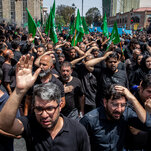
Iran’s Ashura Rituals Have Become a New Form of Protest

Ashura, which mourns the killing of the Prophet Muhammad’s grandson and celebrates Shiite identity, has long symbolized the fight against oppression. This year, its chants have been turned against the government.

The large crowd of men congregated at the center of a mosque in the central city of Yazd, clad in black and beating their chests rhythmically in unison. They were commemorating Ashura, Shiite Islam’s most sacred ritual, showcased annually with great fanfare in Iran as a testament to the Shiite theocracy’s power and strength.
But this year Ashura looked different. The mourners who gathered in Yazd last month and in many other cities across Iran diverged unexpectedly from the script to target the clerical rulers of Iran, turning religious ballads into protest songs about the suffering of Iranians.
“For a city in ruins, for all of us held hostage, for the grieving mothers, for the tears of the marginalized,” the men sang, according to videos. “We are mourning thousands of innocent lives, we are ashamed of this raging fire. Oh rain, oh storm, come. They have set fire to our tent.”
In Kermanshah, a Kurdish city in western Iran, a religious vocalist known as a maddah stood on the street, microphone in hand, singing about officials “stealing and devouring” resources away from desolate people.
And in Dezful, a small conservative city in the southwest, a similar vocalist delivered a scathing sermon against the government as the crowd marched in a ritual procession.
“Oh, my country, do you know why I’m grieving? Their only concern is hijab. They don’t see the blood, the poverty. They are stealing the public’s money,” serenaded the vocalist, Ibrahim Nassrollahi. “Fathers are ashamed, mothers are suffering. I wish they would see our poverty.”
Instead of the traditional chant that describes an ancient tale of grief, the crowd shouted back: “Iran, Iran, Iran!”
Image
Image
It was a surprising tone for the period of religious mourning known as Muharram, which lasts for a little over a month in Iran. This year it will end on Sept. 6, with another big public ritual called Arbaeen that is expected to also become a platform for protest.
Ashura, which marks the 10th day of the mourning period, grieves for Imam Hussein, the grandson of the Prophet Muhammad, who was beheaded in the year 680 in the battle of Karbala. Imam Hussein led an uprising against the succession of Islam’s new caliph, Yazid, on the basis that his rule was corruption and unjust, and in Karbala his small force was confronted by Yazid’s massive army and slaughtered.
For centuries Ashura has been more than just a religious ritual. From Iran, to Iraq, Afghanistan, Lebanon and beyond, it has served as a celebration of Shiite Muslim identity. Even some secular people participate in its stylized rituals, ranging from street processions to theatrical re-enactments and food handouts organized by neighborhood committees.
Social and political movements in the Muslim world have long been fueled and inspired by the narrative of Ashura, of the oppressed rising up against an oppressor. In Iran during the 1979 revolution that toppled the monarchy, a huge protest on Ashura became a turning point against the Shah. During the country’s Green Movement in 2009, protesters, mostly young and upper middle class, took to the streets on Ashura to contest presidential election results.
Under Saddam Hussein’s rule, Iraqi Shiites were banned from publicly commemorating their mourning holidays. The Taliban government in Afghanistan recently announced a similar ban.
In previous years, maddahs in Iran occasionally delivered sermons with mild and indirect criticism of the government. This year, some of the ceremonies were the traditional grand spectacles and religious processions.
But the widespread and remarkable politicization of Ashura directly targeting the leaders of the Islamic Republic rattled the authorities, who warned that the protest tone was “making our enemies happy.” There were reports on social media of the brief detention of some of the leading vocalists and demands from the government that they tone down their rhetoric.
“The enemy had unpleasant dreams for Muharram this year,” Mohammad Mehdi Esmaili, Iran’s minister of Islamic guidance and culture, said on Monday. “They wanted to turn Muharram into the latest battlefield, but our people did not listen at all.”
But analysts said that instead of issuing fanciful denials, the government must reckon with the stark reality that opposition to it has now spread to some devoutly religious Iranians, who were once considered a loyal power base. The rebellion on display presents yet another challenge to the legitimacy of a theocracy that views itself as the global spiritual leader of Shiite Muslims.
Image
Image
Mohamad Ali Ahangaran, a conservative analyst of religion and the son of a prominent maddah who performs at government events, said in an interview from Tehran that many Iranians were using every opportunity, including Ashura, to voice their opposition to the status quo.
“This year we saw the religious sermons and songs become more protest-driven than previous years, targeting the way the leaders are governing Iran, the widespread corruption in the Islamic Republic, the political obstacles we face,” Mr. Ahangaran said.
Iran’s supreme leader, Ayatollah Ali Khamenei, has repeatedly encouraged Muharram ceremonies to be more political and take sides, but he never envisioned that in doing so it would one day turn “against the entire leadership” of Iran, including himself, said Mr. Ahangaran.
Nearly a year ago, Iranians took to the streets in nationwide protests demanding an end to the clerical government. The uprising was set off by the death of 22-year-old Mahsa Amini in the custody of the morality police, who had detained her on allegations of violating the mandatory hijab law. The government responded with violence, killing over 500 people, including children, arresting tens of thousands and executing seven protesters.
“We saw the story of Ashura unfold in the streets with our own eyes as they slaughtered our youth last year,” said Maryam, 55, a mother of two in Tehran, who asked that her last name not be used, fearing retribution. “As a religious person, I want to completely separate myself from any ceremony connected to the regime.”
Maryam said her mother hosted a mourning ceremony at home early this month for nearly 200 guests. She adorned the salon with black Ashura flags with Imam Hussein’s name and placed a picture of a killed protester next to each flag. “They are our new martyrs,” she said.
The 33-year-old son of a senior cleric in the religious city of Qom said that he was boycotting the Muharram ceremonies because of his opposition to the government and its violence. His relatives, he said, searched for ceremonies that either were not political or took on the regime. He also requested anonymity, fearing for his safety.
Some Iranians wore white, in defiance of the customary black attire, and trekked to cemeteries to pay homage to killed protesters. In the northern city of Amol, a religious marching band dressed in white went to the home of Ghazalleh Chelavi, 33, a female athlete shot in the head during protests last September, videos showed. Her mother wailed by the door.
In Yazd, the maddah led the crowd in singing a famous poem that honors protesters killed by governments: “From the blood of our country’s youth, tulips grow.”
Then, comparing the authorities in power to wheels, they continued, “Oh, wheel, how you have derailed, how you misbehave, how you take revenge. Oh, wheel, you have no religion and no principles.”
Ms. Amini’s mother posted a video on Instagram of her daughter’s grave illuminated by candlelight at night on Ashura. A woman’s voice could be heard singing the same poem.
Image
Farnaz Fassihi is a reporter for The New York Times based in New York. Previously she was a senior writer and war correspondent for the Wall Street Journal for 17 years based in the Middle East. More about Farnaz Fassihi
Source: https://www.nytimes.com/2023/08/13/world/middleeast/ashura-iran-protests.html
















